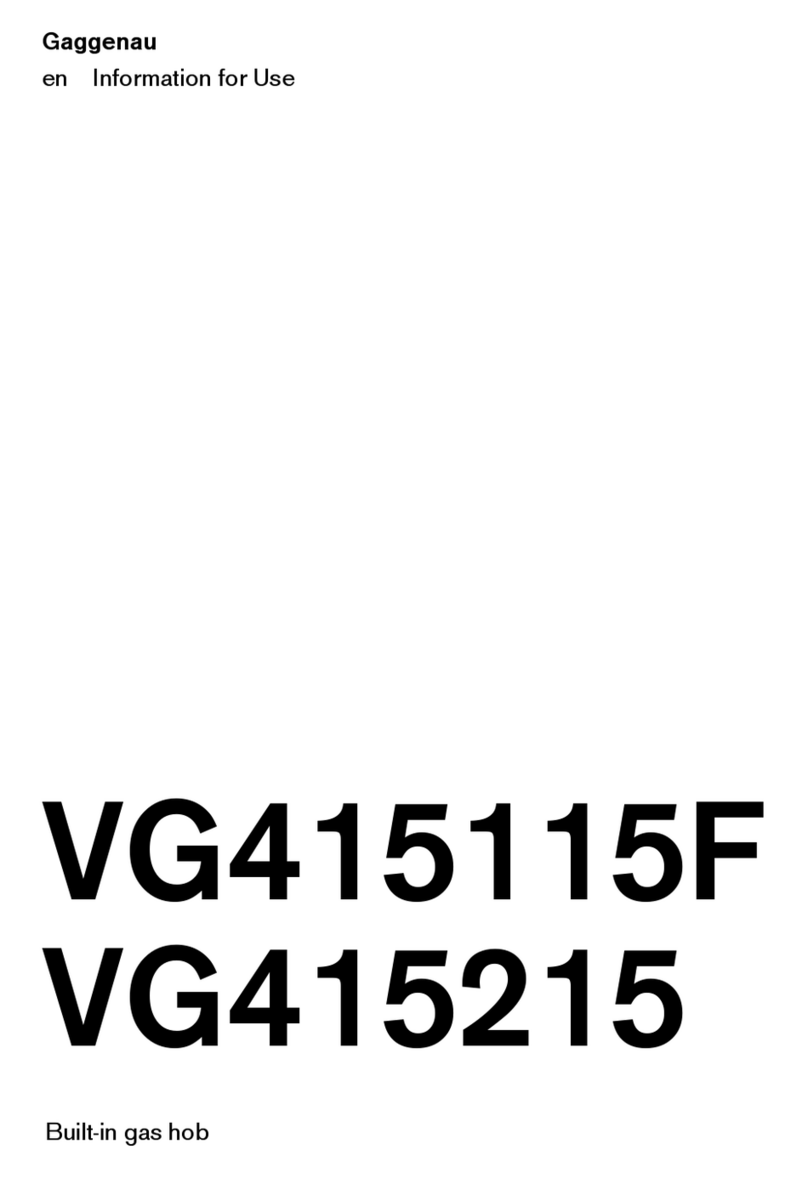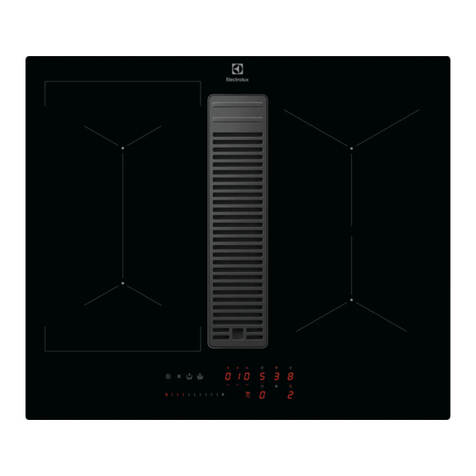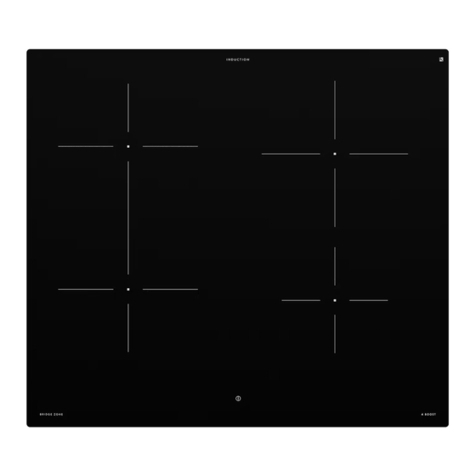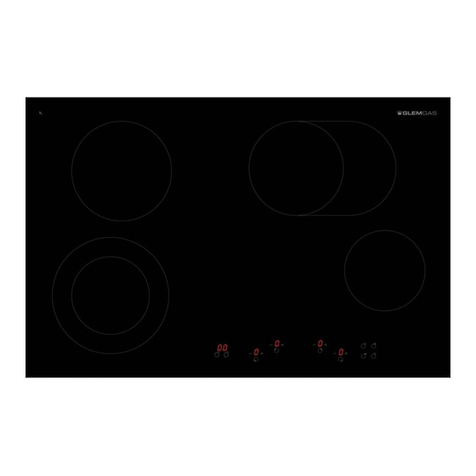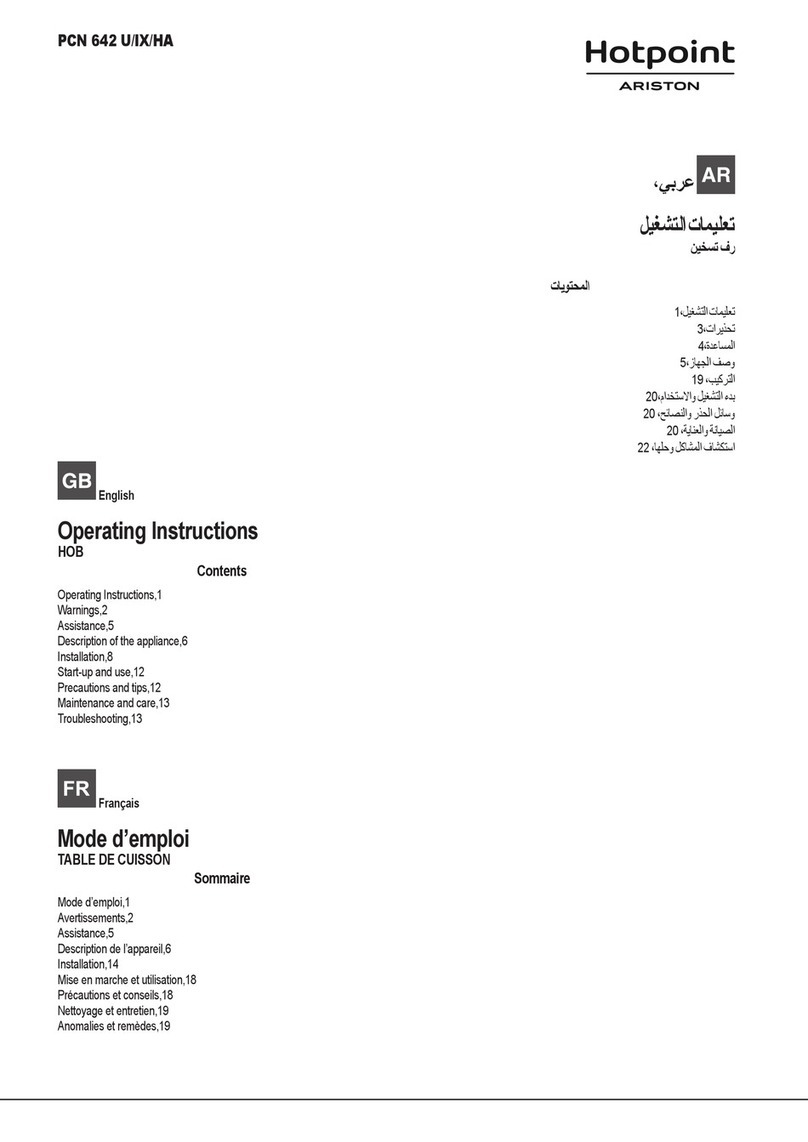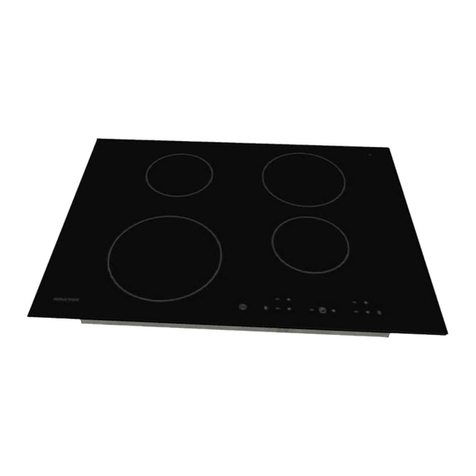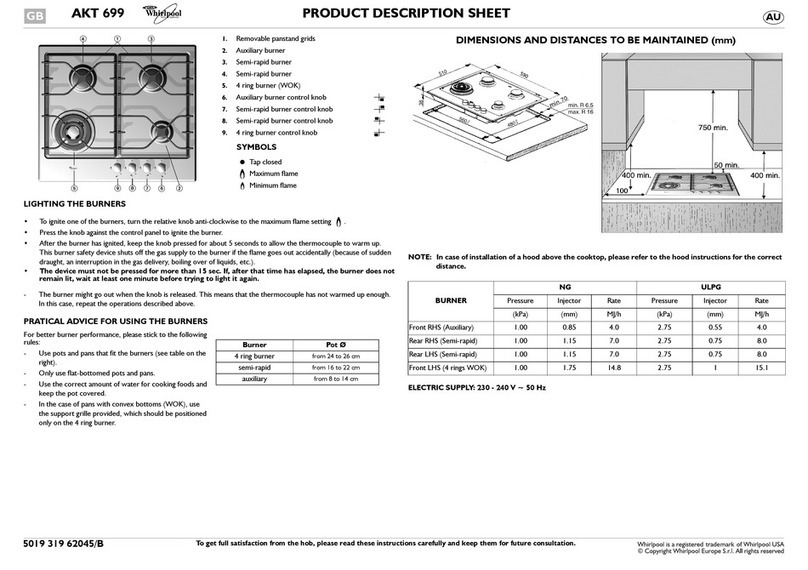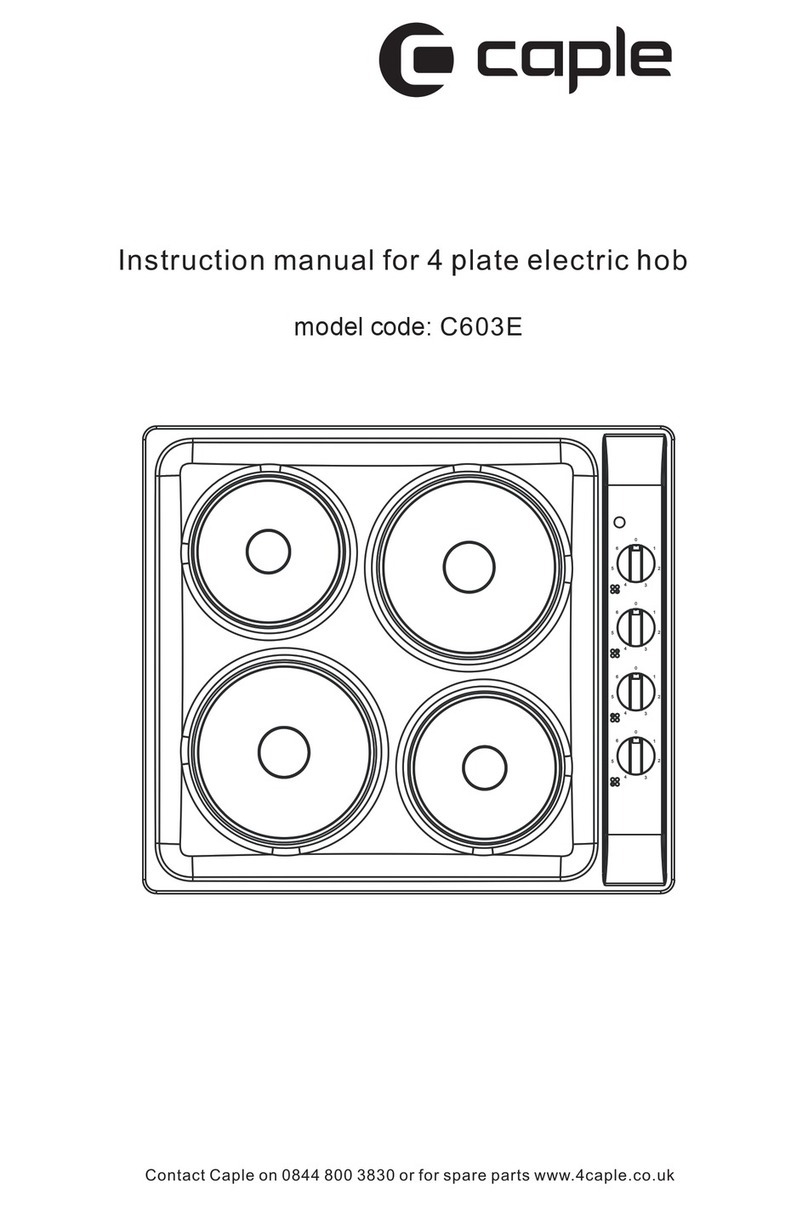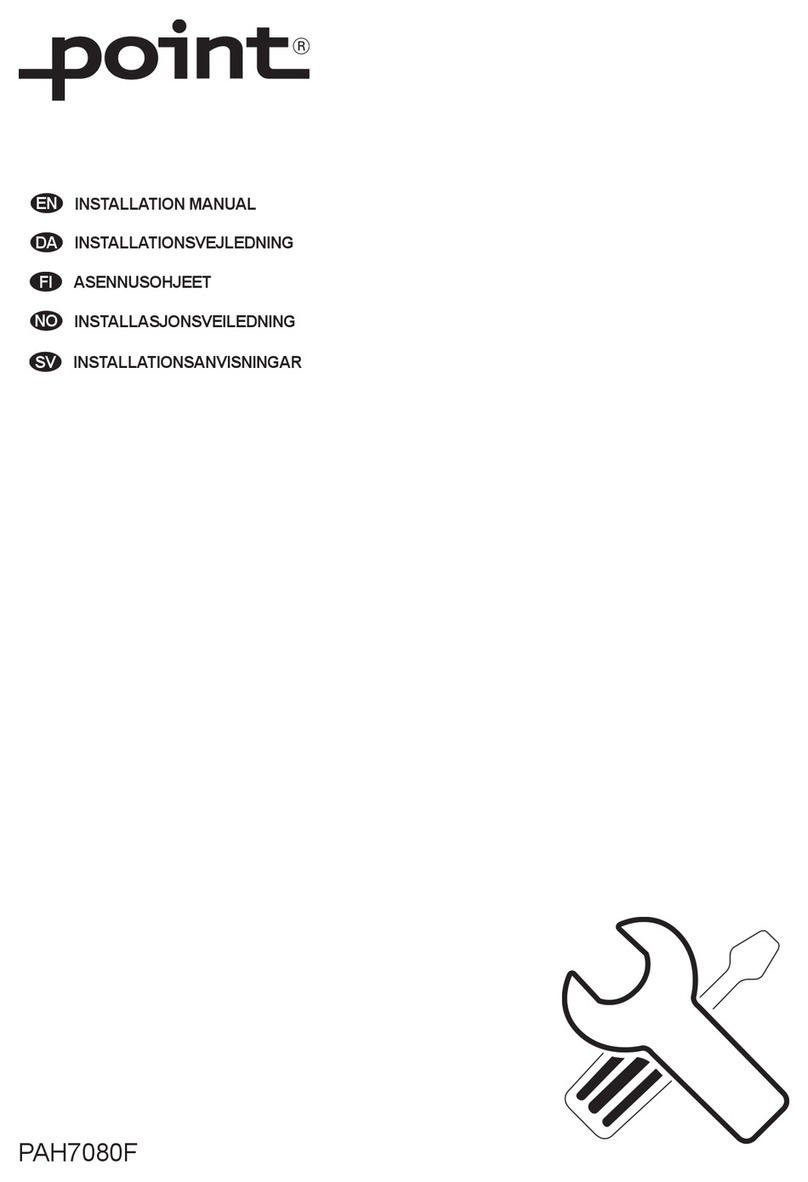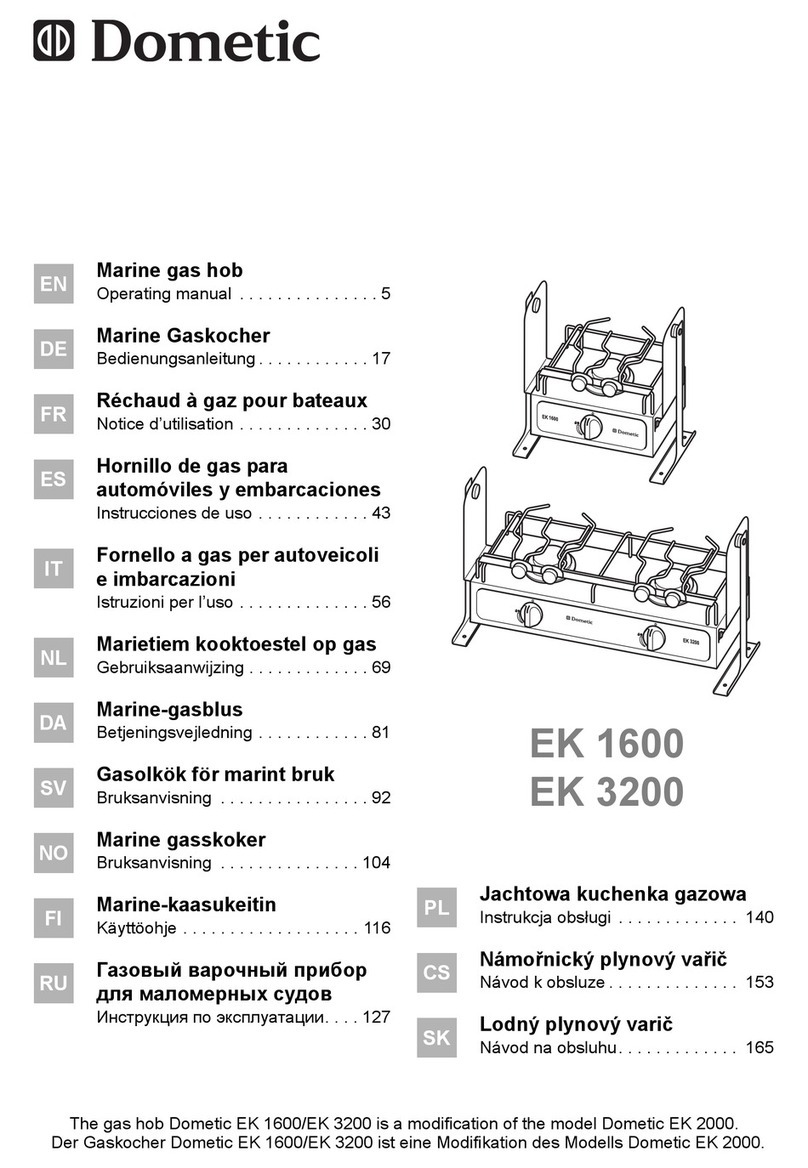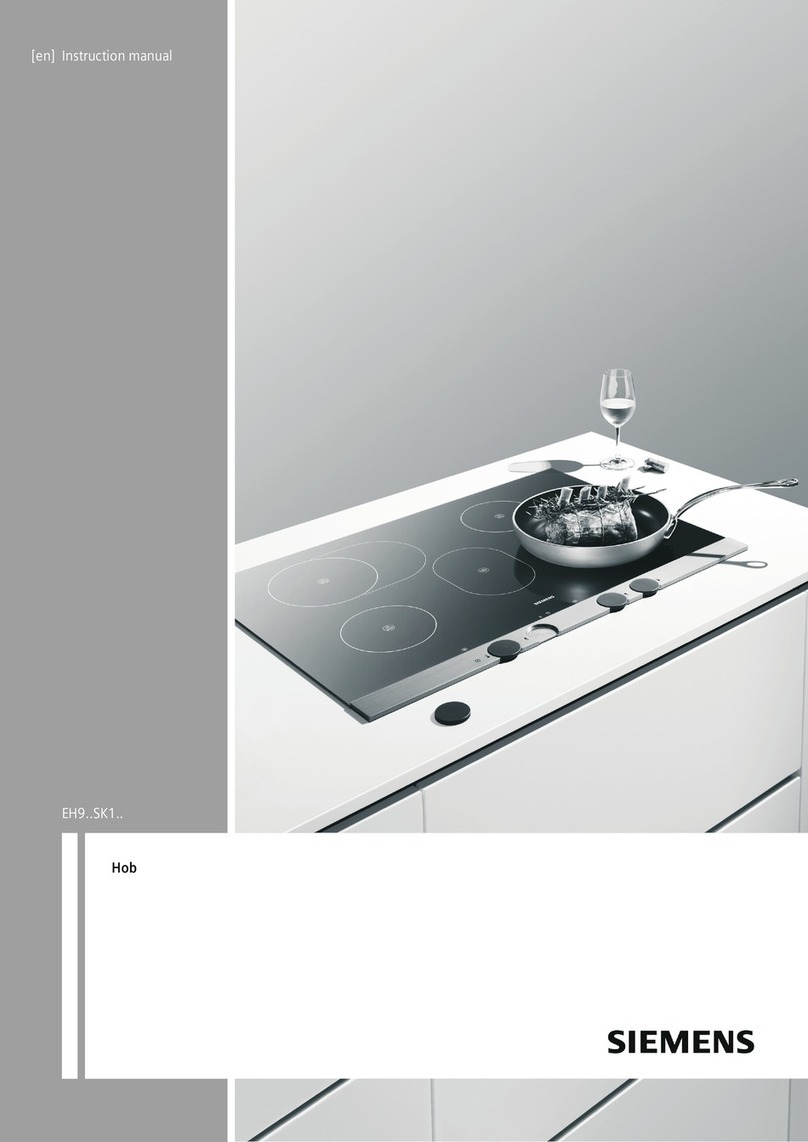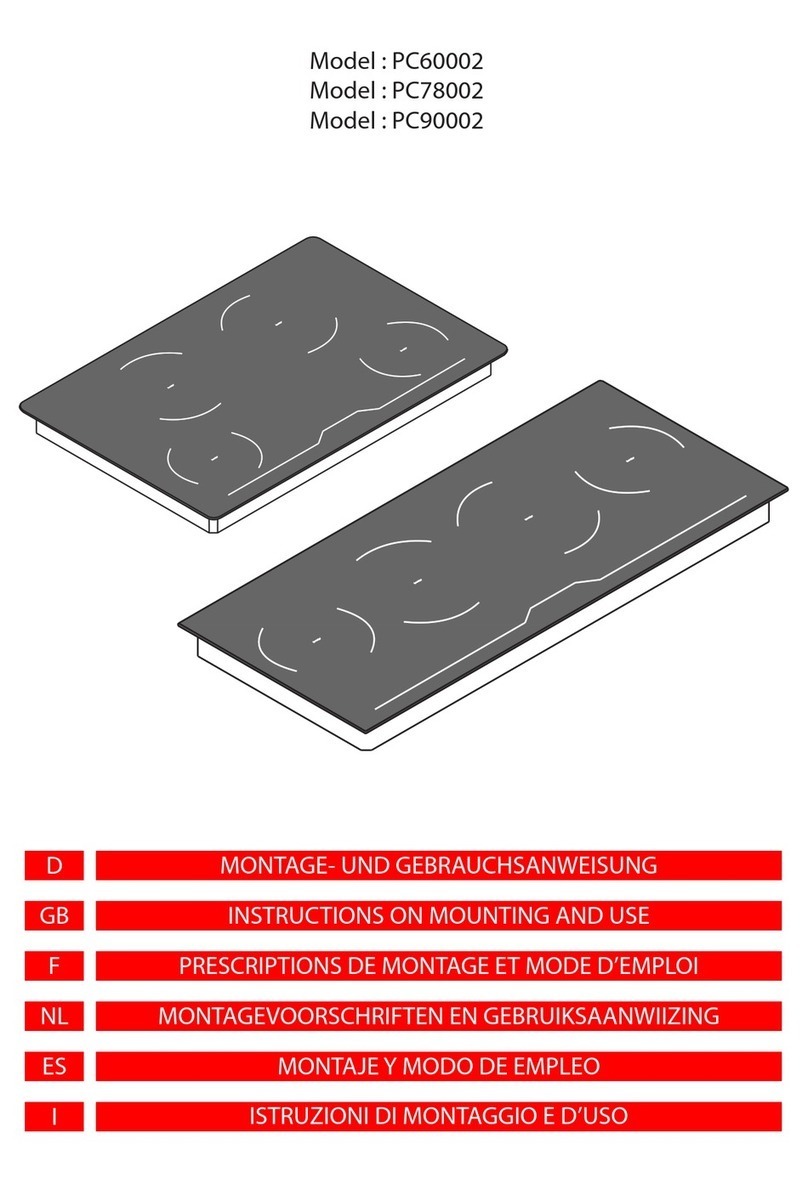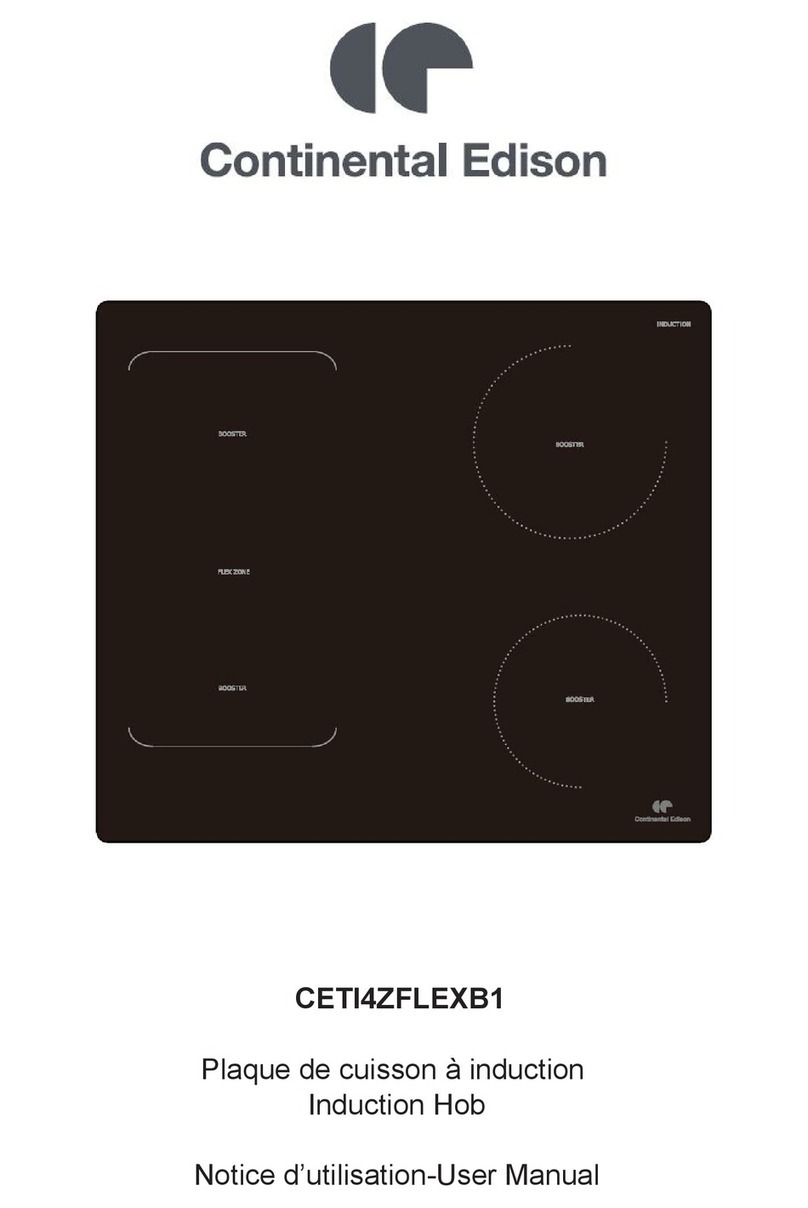CHEFOOK CT74GPC Operating and maintenance manual

GAS PASTA COOKER
Instructions for installation,
use e maintenance
01/2016
CT74GPC

CHARACTERISTICS
0820_GB_99 - GAS PASTA COO ER
2· 12
01/2016
Supplied by:
Date:
Customer Service:
FAX
e-mail

INDEX
1 Diagram 4
2 Characteristics of the appliances 5
3 Technical data 5
4 Installation instructions 6
4.1 Safety rules 6
4.2 Structure, framework and safety devices of the appliances 6
4.3 Assembly 6
4.3.1 Installation premises 6
4.3.2 Statutory regulations and technical requirements 6
4.3.3 Installation 6
4.3.4 Gas connection 6
4.3.5 Water connection 6
4.3.6 Equipotential 6
5 Operation preparation 7
5.1 Preparation and Start-up 7
5.1.1 Start-up 7
5.1.2 Check of power 7
5.1.3 Checking the input pressure 7
5.1.4 Power check with volumetric method 7
5.1.5 Power check for operation with liquid gas 8
5.1.6 Operation control 8
5.1.7 Check of pilot flame 8
5.1.8 Checking the primary air 8
5.1.9 Operator training 8
5.1.10 Conversion and adjustment 8
5.1.11 Replacement of urner injector 8
5.1.12 Replacement of urner pilot injector 8
5.1.13 Setting reduced capacity power 9
5.2 Maintenance 9
5.3 Replacing parts 9
5.3.1 Gas cock 9
5.3.2 Thermocouple 9
5.3.3 Plug 9
5.3.4 Burner 9
5.3.5 Safety thermostat 9
6 Instructions for use 10
6.1 Safety, cleaning and repair rules 10
6.2 Start-up 10
6.2.1 Lighting pilot urner 10
6.2.2 Lighting the main urner and temperature adjustment 10
6.3 Cleaning and taking care of the machine 10
6.4 Turning the appliance off in case of breakdown 10
6.4.1 What to do in case of failure 10
6.4.2 What to do in case of prolonged period of disuse 10
6.5 Appliance care and fre uency of maintenance 10
6.6 Recommendations for handling “stainless steel” industrial
kitchens 10
6.6.1 Useful information on “stainless steel” 10
6.6.2 Warnings and advice for maintenance of “stainless steel”
appliances 11
6.6.3 WEEE Directive 11
3· 12
0820_GB_99 - GAS PASTA COO ER 01/2016

0820_GB_99 - GAS PASTA COO ER
4· 12
01/2016
1 - DIAGRAM
1
4
4
3
1
7
1
6
7
6
4
4
1
6
4 3
4
4
D
Gas 1/2"
Water load
pipe Ø12
Water drainpipe
1"GC female
Gas 1/2"
Water load
pipe Ø12
Data plate
Water drainpipe
1"GC female
Gas 1/2"
Water load
pipe Ø12
Data plate
Data plate
Gas 1/2"
Water load
pipe Ø12

2 - CHARACTERISTICS OF THE APPLIANCES
3 - TECHNICAL DATA
0820_GB_99 - GAS PASTA COO ER
5· 12
01/2016
Description
Gas pasta cooker
N Tank
1
Capacity
26 l
Dimensions in mm. (LxDxH)
400 x 700 x 900
N.
51BS3549
Model
CT74GPC
Primary air distance “A” mm
Methane gas G20
Liquid gas G30/G31
Category
Construction type
Air necessary for combustion
Nominal thermal power
Minimum thermal power
Overall thermal power (gas)
Connection pressure
Methane gas 2H
Liquid gas 3+
Gas connection values
Methane gas 2H
Liquid gas 3+
Nozzles Ø 1/100 mm
Main burner
G20
G30/G31
(HuB = 9.45 kWh/m3) in m3/h
(HuB = 12.87 kWh/kg) in kg/h
Nominal thermal power
Minimal thermal capacity
Nominal thermal power
Minimal thermal capacity
G20
G30/G31
20 mbar
28/37 mbar
II2H3+
A
m3/h
kW
kW
No. of nozzles pilot burner
G20
G30/G31
22
20
0.952
0.704
230
Adjustable
150
100
Adjustable
20
Model
CT74GPC
18
9.0
3.8
TABLE 1
These appliances are used for professional purposes. Installation,
repair and use must be carried out by expert personnel.
These instructions for installation are for our gas pasta cooker set up
for the category in the table 1 on pag. 5. The data plate is located
on the appliance, see diagram. Beware of inexpert handling.
0051
TIPO/TYPE
CAT/KAT GAS/GAZ G30 G31 G20 G25
II2H3B/P P mbar 30 30 20 -
II2H3+ P mbar 30 37 20
-
-
II2H3+ P mbar 28 37 20 -
25II2L3B/P P mbar 30 30
II2ELL3B/P P mbar 50 50 20 20
II2E+3+ P mbar 28 37 20 25
II2H3B/P P mbar 50 50 20 -
I2E P mbar - - 20 -
- -II2H3B/P P mbar 30 30
II2H3+ P mbar 28 37 20 -
- -
- -
I3B/P P mbar 30 30
I3+ P mbar 28 37
SE FI DK CZ SK SI
IT CH PT
ES IE GB GR
NL
DE
FR BE
AT CH
LU
EE LV LT
EE LV LT
NO MT CY IS HU
CY
MOD.
MOD.
ART.
N.
N.
Qn kW
m3/h
MADE IN ITALY
Predisposto a gas: - Gas preset: - Prevu pour gaz:
Eingestelt für Gas: - Preparado para gas: -
Geschuckt voor:
VAC kW Hz
THE APPLIANCE MUST BE CONNECTED IN COMPLIANCE WITH THE LAWS IN FORCE
AND INSTALLED IN A WELL-VENTILATED ROOM. READ THE INSTRUCTION MANUALS
BEFORE INSTALLING AND USING THE APPLIANCE.
THE APPLIANCE MUST BE INSTALLED BY QUALIFIED PERSONNEL.
G30/G31 28/37 mbar
G20 20 mbar

4 - INSTALLATION INSTRUCTIONS
4.1 Safety ules
• Installation, modifications and maintenance of the appliance
must be carried out by authorised personnel in compliance with
current safety standards. The manufacturer declines all responsi-
bility for failure to comply with these obligations.
• Ventilation system installation can be carried out only by expert
personnel.
• If the appliance is to be installed near walls, dividing walls, kit-
chen equipment or decorative panelling, these should be in non-
inflammable material. If not, all appliances must be coated with
thermal-insulation fireproof material. Make sure that all fire pre-
vention standards and safety precautions are strictly adhered to.
4.2 St uctu e, equipment and safety devices
of the unit
Robust steel frame, with 4 height adjustable feet.
teel outer panelling.
The water is heated by a tubular stainless steel burner, which is resi-
stant to thermal and mechanical stress.
The combustion chamber and flues are made of electrogalvanised
steel sheeting.
4.3 Assembly
4.3.1 In tallation premi e
This is a type A1 appliance. It must be installed in an adequately ven-
tilated room in order to avoid potentially unacceptable concentra-
tions of harmful substances in the space in which the appliance is
installed. This room must meet all applicable local and national reg-
ulations.
The appliance must be installed in an adequately ventilated room in
order to ensure the air flow necessary for combustion, in accordance
with all applicable local and national regulations.
The appliance can be installed on its own or with other similar
equipment.
If the appliance is to be installed near inflammable walls, a minimum
distance of 150 mm around the sides and back should be allowed.
If this distance cannot be obtained, take proper heat-protection
action such as fitting tiles or thermal radiation protection material
to the walls.
Before connecting the appliance to the gas supply, check on the
data plate that the appliance is suitable and type-tested for the type
of gas available.
If the type of gas indicated on the data plate of the appliance does
not correspond to the gas which is present, refer to the paragraph
5.1.10 “Conversion and adaptation”.
4.3.2 Statutory regulation and technical requirement
During installation of the appliance, the following regulations must
be adhered to:
• Relevant legal directives;
• Local building and combustion regulations;
• "Technical rules for gas systems" worksheet;
• "Technical rules for liquid gas" worksheet;
• “Gas installations in industrial kitchens” worksheet;
• Relative accident prevention standards;
• Local gas utility regulations;
• Local building and fire codes.
4.3.3 In tallation
Before installation, gas connection, power check, conversion or adju-
stment and start up ask for gas supply company advice.
4.3.4 Ga connection
The gas connection may be made with a continuous wall, stainless
steel flexible hose with a maximum extension of 1.5 metres, in
accordance with all applicable local and national regulations. Hoses
must not pass through spaces which might become crammed with
items and they must not come into contact with any moving parts
such as drawers.
After completing gas connection, check for leaks using a special
leak-detector spray.
4.3.5 Water connection
It is mandatory for the appliance to be installed in accordance with
EN 1717 as well as with all applicable local and national regulations.
The inlet pipe has a 12 mm diameter.
4.3.6 Equipotential
The appliance must be hooked up to a unipotential system.The
required terminal is located near the power cable and it is marked
by a tag with a symbol .
The manufacturers cannot be held responsible for any dam-
age due to inadequate or incorrect installation. Under such
circumstances the guarantee will be considered null and void.
6· 12
0820_GB_99 - GAS PASTA COO ER 01/2016

5.1 Preparation and Start-up
Before starting up the appliance, remove the protective wrapping.
Then carefully clean the working surface and the external parts with
lukewarm water and detergent, using a damp rag to remove all traces
of anti-rust material applied in the factory, then dry with a clean cloth.
5.1.1 Start-up
Before using the appliance for the first time, thoroughly clean out
the tank (see the chapter 6.3 “Cleaning and taking care of the
machine”).
Before starting up the appliance, check that its specifications (cate-
gory and type of gas used) match those of the family and group of
the gas available locally.
If not, it is necessary to adapt the appliance to the gas family or
group required (see paragraph 5.1.10 “Conversion and adaptation”).
To start up the appliance, see the instructions for regular use.
5.1.2 Check of power
The appliances must be used with the specific injectors for the nomi-
nal power.
The power may be:
• the nominal power indicated on the data plate of the appliance;
• the reduced capacity power.
These injectors are shown in table 1.
Nominal power is also obtained in respect of the supply pressure:
• from 15 to 22.5 mbar for gases of the second family (G20/methane)
• from 25 to 45 mbar for gases of the 3rd family
(G30/butane, G31/propane)
The appliance shall not be operated outside the above-mentioned
pressure ranges.
To adjust power with reduced capacity, use the data in table 1.
If you wish to further check the nominal power, you may do so by
using a gas meter according to the so-called "volumetric method".
A simple inspection is usually enough to check if injectors are func-
tioning correctly.
5.1.3 Checking the input pressure
Input pressure should be measured using a fluid measuring gauge
(e.g. a gooseneck pipe, min. resolution 0.1 mbar).
Remove lock screw (pos. 22 fig. 1) from the pressure intake tube and
connect the gauge hose: once measurement is complete, replace the
screw and do a seal check using a leak detector spray.
5.1.4 ower check with volumetric method
Using a gas meter and a stopwatch, you can read the volume of gas
output per time unit. The correct volume corresponds to the value
"E" expressed in litres/hour (l/h) or litre/minute (l/min).
The following formula is used to calculate the value of “E”:
It is important measure the power when the appliance is in standby
status.
The calorific power value can be requested from the local gas company.
The nominal power and the minimum power with respect to the
nominal pressure are obtained by consulting the table for the
adjustment of the gas passage (table 1).
WARNING
There is no pre-adjustment device for the nominal
power.
E=Power
Operating calorific value
5 - SET-UP FOR OPERATION
0820_GB_99 - GAS PASTA COO ER
7· 12
01/2016
4
22
6
1
5
3
2
21
24
0
Fig. 1

5 - SET-UP FOR OPERATION
0820_GB_99 - GAS PASTA COO ER
5.1.5 ower check for operation with liquid gas
Check if the type of injectors used meet the data of the table 1.
Check that the pressure reducer installed in the system has an outlet
pressure which is compliant with paragraph 5.1.2 "Check of power"
(can be checked on the data plate of the appliance or on the table
1).
5.1.6 Operation control
• Start the appliance in accordance with the instructions.
• Check that the appliance does not have any leaks by using a leak-
detecting spray.
• Check ignition and that flame on the main burner lights properly
and is correctly formed, even on low.
• A servicing and maintenance contract is recommended.
5.1.7 Check of pilot flame
For proper regulation, the pilot flame must surround the thermocou-
ple and it must have a perfect appearance; otherwise, check gas
pressure, make sure the injector is clean and has the right diameter
for the gas, see table 1.
5.1.8 Checking the primary air
The burner is equipped with primary air adjustment. Distance “A”
(fig. 2) see table 1.
Air volume flow is correct when there is sufficient protection again-
st the flame rising when the burner is cold or in case of flashback
when the burner is hot.
5.1.9 Operator training
• Explain and show the user how the machine works according to
the instructions, and hand him this manual.
• Remind the user that any structural alterations or any building
modification or renovation may affect the combustion air supply,
thus requiring a second operation check.
5.1.10 Conversion and adjustment
To change over form one kind of gas to another, for example from
methane to liquid gas, or to another type of gas, the use of suitable
injectors for the main burner is required, in accordance with the
table 1.
The injectors of the main burners and pilot for different types of
gas, marked with the relative diameter in hundredths of mm, are in
an envelope which is provided with the appliance. If injectors are
not available please contact the factory with model and serial num-
ber written on technical data sticker. After transformation or adap-
tation, carry out operating checks as described in paragraph 5.1.6
“Operation control”.
5.1.11 Replacement of burner injector
To replace the injector (pos. 30 fig. 2), open the doors. Unscrew the
injector from the injector-holder using a 12 spanner (pos. 29 fig. 2)
and replace the injectors with one able for the type of gas, see
table 1, install in reverse order. If necessary, disassemble the air
adjustment (pos. 33 fig. 2) by loosening the screws (pos. 39 fig. 2),
this will make replacement easier.
After fitting the new injectors, reset primary air distance “A” (fig. 2)
see table 1, and fasten the bushing with the appropriate screw.
After the replacement check the seal using a leack detector spray.
5.1.12 Replacement of burner pilot injector
To replace the pilot injector (pos. 34 fig. 3) open the doors. Unscrew
the nut (pos. 35 fig. 3) and with the help of a screwdriver unscrew
and replace the injectors with one able for the type of gas, see
table 1.
Screw the nut in again ensuring the seal is inserted too.
8· 12
01/2016
38
37
39
34
36
35
33
Fig. 3
A
32 30
39
33
31
28
29
Fig. 2

5 - SET-UP FOR OPERATION
0820_GB_99 - GAS PASTA COO ER
After the replacement check the seal using a leack detector spray.
5.1.13 Setting reduced capacity power
The minimum setting screw (pos. 2 fig. 1) should be adjusted as fol-
lows:
• for operation with LPG it should be screwed all the way down;
• for operation with methane, use the gas flow table to check the
value in l/min with respect to the operating alorific value (mea-
surement in accordance with the volumetric method). Start the
appliance in accordance with the instructions. Turn the knob to
the minimum position and use screw (pos. 2 fig. 1) to adjust the
flow (clockwise = flow reduction; conter-clockwise = flow
increase).
5.2 Maintenance
Attention! Before doing any repair or maintenance
work, unplug the appliance.
The following maintenance program should be carried out at least
once a year by qualified personnel with license:
• Check that all the safety and adjustment devices are working
properly;
• Check that the burners are working properly with regard to:
- ignition
- combustion safety;
Check functioning of the appliance as described in paragraph 5.1.6
“Operation control”.
5.3 Replacing parts
All parts must be replaced by authorized technicians
only!
To replace the following parts first remove all the control knobs and
control panel (after loosening the fixing screws), then extract the
ignition wire.
5.3.1 Gas cock
Loosen the fitting of the pipe (pos. 3,4 and 5 fig. 1) of the gas and
of the thermocouple (pos. 6 fig. 1) and replace the piece (pos. 1 fig.
1) install in reverse order. After the replacement check the seal using a
leack detetctor spray.
5.3.2 Thermocouple
Unscrew the nut (pos. 6 fig. 1) fixing the thermocouple on the cock,
unscrew the screws (pos. 36 fig. 3) and replace the piece (pos. 38 fig.
3) install in reverse order. To make the operation easier (as well as all
those involving the pilot burner), the screws can be removed (pos. 33
fig. 3) and the pilot burner brought to a more comfortable position.
5.3.3 lug
Unfix the cable (pos. 39 fig. 3) from the plug, unscrew the two
screws (pos. 36 fig. 3) on the pilot burner and replace the plug (pos.
37 fig. 3). To make the operation easier (as well as all those involving
the pilot burner), the screws can be removed (pos. 33 fig. 3) and the
pilot burner brought to a more comfortable position.
5.3.4 Burner
Remove the air adjustment (pos. 33 fig. 2),unscrew the screws (pos.
39 fig. 2), unscrew the nut fixing the injector-holder (pos. 28 fig. 2),
and pull off from the burner, unscrew the screws (pos. 32 fig. 2)
fixing the burner to the combustion chamber, pull down the burner
(pos. 31 fig. 2) to free it from the rear centering pin, pull off and put
in a new piece in the reverse order. After the replacement check the
seal using a leack detector spray.
5.3.4 Safety thermostat
The substitution of the safety thermostat (with the bulb located
under the tank and properly protected) can be made removing the
front panel and dismantling the door by loosening the lower pivot
and then taking the screws of the front panel off.
In the central area below the surface and on the higher side of the
tank, remove the nut and the washers that keep in position the pro-
tection of the bulb.
Remove the bulb protection from the internal side of the tank by
sliding it, then remove the bulb by sliding it through the hole of the
screw placed in the tank to keep the protection in place (remove
the red and high temperature-resisting silicone put on the external
side of the tank and on the seat of capillary of the bulb), finally
take off the safety thermostat removing the nut placed below the
support of the front panel.
Substitute the thermostat following the above mentioned steps
backwards, and taking care to place the capillary in the above men-
tioned seat in such a way that it is not touched by the nut keeping
the protection in place and also extending the capillary along the
tank and below the protection in such a way that it does not come
out and it is not plied.
Ensure that the bulb is in place, pressed under its protection and
well adhering, in its entire length, to the bottom of the tank.
After blocking the bulb, put again some silicone and wait until it
dries and put the front panel and the door back in their seats.
After any maintenance or repair work, replace the con-
trol panel and the lower panel.
After replacing gas input components, check operation
again and test for leakage.
9· 12
01/2016

6 - INSTRUCTIONS FOR USE
6.1 Safety, cleaning and repair rules
• This appliance is used for the preparation of meals at industri-
al level. Usage and cleaning can be carried only by expert per-
sonnel. aintenance and repair can be carried out only by
skilled technical personnel.
• These indications must be communicated to all those con-
cerned during internal training.
• Attention! This appliance must be constantly watched over
when being used!
• Grease and overheated oil can catch fire. Use this appliance
only under constant control. Never use water to put out
grease or oil!
• Do not leave the burners running.
• Parts of the appliance and attachments exposed to food
must be cleaned with detergents and rinsed thoroughly with
potable water.
• Do not clean the appliance using water jets or steam,
whether direct or pressurized!
• If the room is being cleaned with water/steam jets or high-pres-
sure equipment, it is necessary to switch off the appliance first!
• Before starting to clean the appliance, disconnect from the
mains.
• Do not use inflammable liquid to clean the appliance.
• Repairs may be carried out only by skilled personnel.
• During repairs, the appliance must undergo voltage
omnipolar insulation (local switch, i.e. safety load cut-off
switch).
• Noise emission values of the appliance in operation are below
70dB (A). This value is compulsory according to certain national
safety standards.
WARNING
Attention! The manufacturer declines all responsibility concern-
ing mistakes included in these instructions due to translating or
printing errors: the manufacturer also reserves the right to
change the product as he see fits, though without changing its
essential features. The manufacturer declines all responsibility for
any non-compliance with the provisions contained in this manu-
al.
6.2 Start-up
Before using the ppli nce for the first time, thorou-
ghly cle n the t nk with lukew rm w ter nd deter-
gent, using soft cloth to elimin te ll tr ce of the
rust-proofing pplied in the workshop. Dry with cle n
cloth.
Check if the water discharge is closed.
Fill the tank with water to the relevant mark.
6.2.1 Lighting pilot burner
Press the knob (pos. 21 fig. 1) and turn to the left as far as .
Keep the knob pressed down while repeatedly pressing the piezo
ignition button (pos. 24 fig. 1) until the pilot flame catches, you can
see through aperture on the combustion chamber. Keep the knob
pressed down for another 15-20 seconds: if the pilot flame goes out
after the knob is released, start again.
6.2.2 Lighting the m in burner nd temper ture dju-
stment
To light the main burner, after light the pilot burner, place the knob
in the maximum or minimum position so that the main burner igni-
tes. Burner power regulation must be done between the max ( )
and min. ( ) supply position of easily selectable intermediate
levels.
To shut off the burner, turn the knob to the right to position,
the main burner will go out.
To shut off the pilot light, place the knob in position “0”.
6.3 Cleaning and taking care of the achine
• Never clean the appliance with jets of water, whether direct or
pressurised!
• Never clean the appliance before it has cooled down.
• Rinse the surface with clean water and a soft cloth to get rid of
all traces of detergent.
• When finished using the appliance, it should be cleaned thorou-
ghly every evening.
• The surfaces and steel parts should be washed in warm water
using a neutral detergent. Avoid using abrasive or corrosive
detergents which could damage the steel.
• Thoroughly dry the appliance.
• Cleaning the appliance daily guarantees perfect long-term ope-
ration.
6.4 Turning the appliance off in case of
breakdown
6.4.1 Wh t to do in c se of f ilure
In case of breakdown or malfunctioning or failure close the gas
cock. Close the connecting cock of the unit. Call the service centre.
6.4.2 Wh t to do in c se of prolonged period of disuse
When the appliance is not to be used for a long time, clean thor-
oughly, cas instructed in the chapter 6.5 “Appliance care and fre-
quency of maintenance”, close the connecting cock of the unit.
6.5 Appliance care and frequency of aintenance
Attention! When cle ning, c refully void w shing the
ppli nce with direct w ter jets or high-pressure
w ter!
Cle ning must be performed when the ppli nce is cold.
Thorough daily cleaning of the appliance, after disconnecting it, will
keep it in perfect working order and make it last longer. All steel
parts should be cleaned with water and a detergent, using a damp
cloth; do not use abrasive substances or corroding detergents.
Do not use steel wool, which could cause rust to form.
For the same reason, avoid touching the appliance with anything
made of iron. Do not clean with sandpaper and lubricating gel paper.
If absolutely necessary, you may use pumice powder.
If the appliance is extremely dirty, use a synthetic sponge (i.e.
Scotchbrite sponge).
After cleaning the appliance, rinse with clean water and wipe with
a clean cloth.
All maintenance and repair work must be carried out by authorized
technicians only.
The appliance must be checked at least once a year. For this reason,
a service agreement contract is recommended.
6.6 Reco endations for the treat ent of
stainless “steel industrial” kitchens
6.6.1 Useful inform tion on “st inless steel”
Industrial kitchens are generally made of “stainless steel” having
the following material codes:
10 · 12
0820_GB_99 - GAS PASTA COO ER 01/2016

6 - INSTRUCTIONS FOR USE
• 1.4016 or 1.4511 = magnetizable chromed steels
• 1.4301, 1.4401 and 1.4571 = non-magnetizable chromed steels
Chromed steels have favourable thermo-technical characteristics. In
fact, they have less of a tendency to warp due to the effect of heat.
Chrome-nickel steels, instead, have good corrosion resistance features.
“Stainless steel” corrosion resistance is given by an inactive coat that
builds up on the surface by coming into contact with oxygen.
The oxygen in the air is already enough to build up the inactive coat
that allows automatic removal of anomalies and damage due to
mechanical actions. The inactive coat builds up or re-builds up faster
if the steel comes in contact with running water containing oxygen.
A more powerful effect is given by oxidative acids (nitric acid, oxalic
acid). These acids are used if the steel has undergone strong chemi-
cal stresses, hence generally losing its inactive coat.
The inactive layer can be chemically damaged or jeopardized by
reducing agents (oxygen consumption) if they come in contact with
the steel, concentrated or at high temperatures. These active sub-
stances include for instance:
• saline and sulphurous substances
• chlorides (salts)
• concentrated spices such as mustard, vinegar essences, soup
cubes, kitchen salt solutions, etc.
ore damage can be caused by:
• outside rust (i.e. from other components, tools or incipient rust)
• iron particles (i.e. file dust)
• contact with non-ferrous metals (element build up)
• lack of oxygen (i.e. no air inlet, water lacking oxygen).
6.6.2 W rnings nd dvice for m inten nce of “st in-
less steel” ppli nces
• “Stainless” steel equipment surfaces must be kept clean and in
contact with air at all times. When not running, keep appliance
doors open so as to allow air to run through it.
• Regularly remove calcium , grease, starch, and egg white deposits
where rust may build up if there is lack of air. Do not use bleach-
ing products or products containing chloride. Follow all indica-
tions given by the company concerning special soaps and clean-
ing methods to be used for the appliance. If no specific cleaning
recommendations are available, it is necessary, however, to use
detergents having a low chloride content. After cleaning, remove
all soap residues with plenty of clean water and thoroughly dry
the surfaces.
• inimize contact of “stainless steel” with concentrated acids,
spices, salts, etc. Even acid vapours coming from cleaning the tiles
favour “stainless steel” corrosion.
• Particularly for pots and multiple appliances, it is not recom-
mended to load the cooking chamber only with food having a
high salt content.
It is preferable to cook different food together, i.e. fatty dishes
or vegetables containing acids.
• Avoid damaging the “stainless steel” surface, in particular with
different metals. Residues from other metals help build up the
formation of chemical microelements that may cause rust. At any
rate, it is appropriate to avoid contact between iron and steel
since it produces rust. Any contact between “stainless steel” and
iron (steel wool, pipeline chips, chalybeate waters) can start cor-
rosion phenomena.
• As for mechanical cleaning, it is recommended to use only steel
wool or natural, plastic or steel bristle brushes. Steel wool or
brushes with “stainless steel” can cause rust due to rubbing. Newly
formed rust spots can be removed with slightly abrasive liquid
soaps or fine-grained sand paper. Larger rust spots can be removed
with 2-3% of hot oxalic acid solution. If these cleaning products do
not do the job, a nitric acid (10%) treatment is required.
Attention! These tre tments c n be c rried out only by
expert personnel ccording to current regul tions!
11 · 12
6.6.3 The 2002/96/EC (WEEE) Directive:
inform tion to users
This informational note is meant only for
owners of equipment marked with the
symbol shown in fig. A on the adhesive
label featuring the technical specifica-
tions applied on the actual product (the
label also giving the serial number).
This symbol indicates that the product is classified, according to the
regulations in force, as an item of electrical and electronic equip-
ment and conforms to EU Directive 2002/96/EC (WEEE) meaning
that, at the end of its service life, it must be treated separately from
domestic waste, i.e. it must be handed in free of charge to a separa-
te waste electrical and electronic equipment collection centre or
returned to the reseller when buying a new equivalent item of
equipment.
The user is responsible for delivering the unit at the end of its life
to the appropriate collection facilities. Failure to do so shall result in
the user being subject to the penalties prescribed by the legislation
in force on waste.
Suitable separated collection so that the unit no longer used can be
sent off for environmentally compatible recycling, treatment and
disposal helps avoid possible negative effects on the environment
and on health and facilitates the recycling of the product's compo-
nent materials.
For more detailed information on available collection systems, con-
tact the local waste disposal service or the shop you purchased the
unit from.
Producers and importers fulfil their responsibility for environmental-
ly compatible recycling, treatment and disposal both directly and by
joining a collective scheme.
Fig. A
0820_GB_99 - GAS PASTA COO ER 01/2016

WARNING
THE MANUFACTURER CANNOT BE HELD RESPONSIBLE
FOR ANY INACCURACIES IN THIS BOO LET DUE
TO COPYING OR PRINTING ERRORS.
DUE TO ITS POLICY OF CONTINUAL PRODUCT IMPROVEMENT,
THE MANUFACTURER RESERVES THE RIGHT
TO MA E ANY CHANGES DEEMED NECESSARY.
THE MANUFACTURER CANNOT BE HELD RES ONSIBLE
IF THE INSTRUCTIONS CONTAINED IN THIS MANUAL
ARE NOT OBSERVED.
Table of contents
